Canada’s untamed natural beauty is (rightfully) world famous. And so are the majestic bears that call it home.
Learning some basic bear safety is absolutely essential for anyone planning to explore beyond the city streets.
While bear attacks remain incredibly rare – you’re more likely to be hit by lightning – it is crucial to know how to avoid a negative encounter and what to do in the very unlikely event it does happen.
This guide will cover essential bear safety tips to help you feel confident to explore the great outdoors, whether you’re visiting Canada for the first time or a long-time resident venturing out of the city.
Last updated September 2023. This post includes affiliate links. If you make a purchase through one of these links, I may receive a small percentage at no extra cost to you.
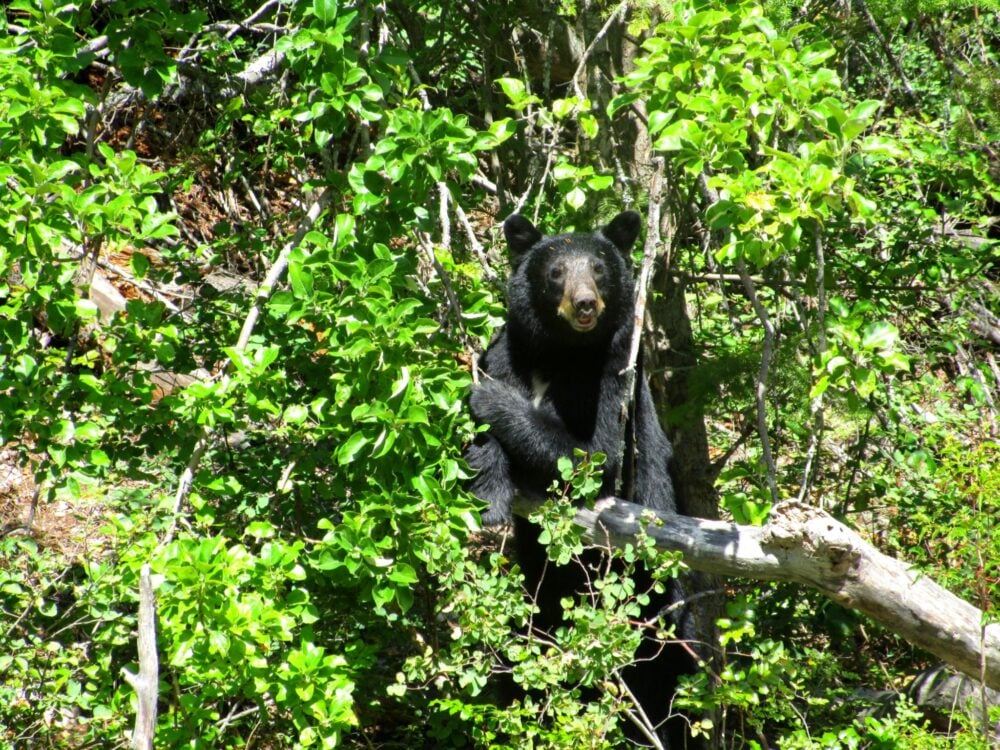
Bear safety basics
It is normal to be frightened at the prospect of encountering a bear, especially if you’re new to Canada or outdoor activities.
I grew up where the most dangerous creature is a rarely seen venomous snake. So I get it. It took me a long time to get over late-night tent paranoia, where every rustle and crunch sounds like a bear!
Now, I’m deeply fascinated by bears and always hope to see one from a safe distance. I do, however, do everything I can to minimise the case of seeing a bear at close range.
Having some fear of bears is healthy (these animals deserve our respect), but it shouldn’t stop you from exploring the outdoors.
The best way to reduce this fear is to learn the basics of bear safety – exactly the purpose of this guide!
Knowledge is power
What has helped me become more comfortable when exploring bear country is knowledge.
These are the facts that have helped me:
- Bears prefer to avoid people
- Humans are NOT on the menu – bears are opportunists and are therefore mostly vegetarian
- The vast majority of bear encounters are a positive experience
- There are ways to proactively avoid encountering a bear
- When used properly, bear spray is extremely effective
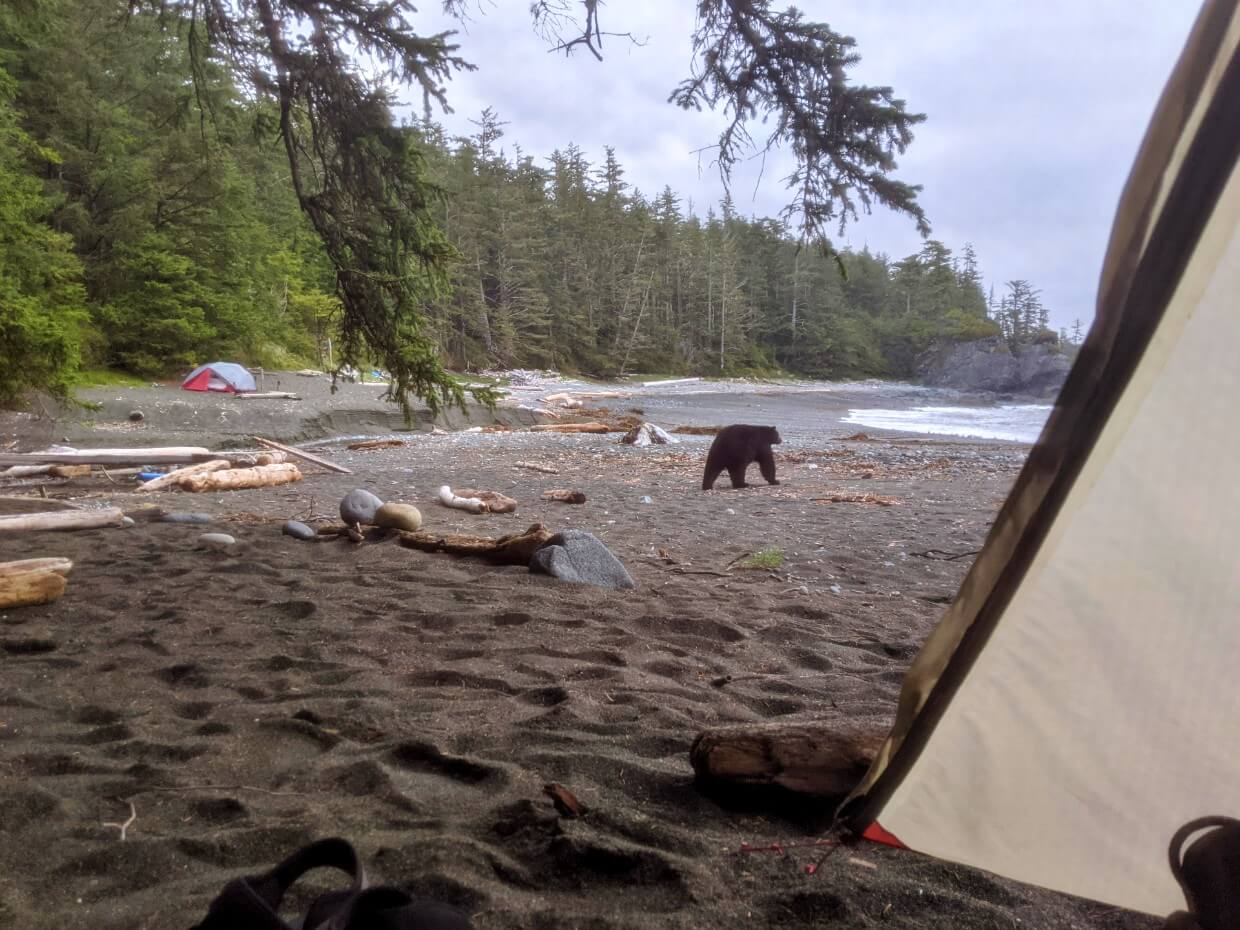
Identifying bears
This guide will cover how to avoid bear encounters and what to do if you see a bear. To start, let’s talk about the different types of bears that live in Canada.
- Black bears are the most commonly seen bear in Canada, living in almost every province and territory (PEI is the only exception)
- Grizzly bears (also known as brown bears) are found in Northwestern Canada, with most located in the coast and mountain regions of British Columbia, Alberta and Yukon Territory
- The Kermode (or ‘spirit’) bear is a famous subspecies of black bear with beautiful white fur. They live around the northern and central coast region of British Columbia
- Two-thirds (around 16,000) of the world’s polar bear population are found in northern ice-covered regions of Canada
I’ll be concentrating on bear safety concerning black and grizzly bears, as they are the two most commonly found bears in Canada.

How to tell black and grizzly bears apart
Black and grizzly bears have varying diets, preferred habitats and physical features. Most important when considering bear safety, they also have different behaviour and defensive techniques.
But telling them apart isn’t always easy.
Size is not a reliable factor. The average weight of an adult grizzly is usually heavier than the black bear equivalent but bears do come in all shapes and sizes, however. An adult black bear, for example, can appear a lot larger than an adolescent grizzly (less than 5 years old).
Colour is also not as clear cut as it may seem. For one thing, bears are not always black! Both black and grizzly bears can vary in shade from blonde (light brown) to very dark brown/black.
Black bears
Usually found in forested and coastal habitats
Excellent climbers – black bears are more likely to climb a tree to escape a threat
Their natural response to threats is to retreat
Flatter, fairly straight face profile with prominent ears
No shoulder hump
Shorter, dark coloured claws
Front toes form an arc
Grizzly bears
Prefers open habitats such as meadows, alpine forest, coast
Less adapted for climbing (but will)
More likely to defend themselves
Dish-shaped snout and face profile, rounded ears
Shoulder hump
Longer, lighter coloured claws
Front toes are in a straighter line
The primary diet of both grizzly and black bears is plants, berries and insects.
Bears are opportunistic and will eat carrion (already dead animals) when they can get it. Coastal bears will feast on salmon in the autumn. Grizzlies are more likely to hunt small mammals as prey.
BearSmart has an excellent quiz designed to test you on the visual differences between grizzly and black bears. I highly recommend having a go!

How to avoid a negative bear encounter
The best way to stay safe around bears is to proactively avoid negative bear encounters. Follow these tips:
- Research your destination first. Find out about the local wildlife. Check for any restrictions or recommended safety precautions
- Read and follow all trailhead signage. Respect trail closures and wildlife warnings.
- Make noise in the backcountry. More info below
- Remain alert at all times. Watch for fresh bear signs like tracks, diggings and scat (bear droppings)
- Stay on the trail and travel in daylight – bears are most active at dawn and dusk
- Avoid animal carcasses. Wildlife, bears included, are attracted to dead animals
- Keep pets on a leash. Dogs can provoke defensive behaviour in bears
- Pack out everything you bring with you, including all garbage and biodegradable items such as apple cores and banana peels
- Travel in a group. The larger the group, the fewer recorded attacks
- Store food safely when camping. Bears are curious and will inspect odours to see if they’re edible
- Learn about bear behaviour. Being able to interpret their postures and vocalisations can be incredibly helpful
- Know how to respond during an encounter or attack
- Carry bear spray (more info below)
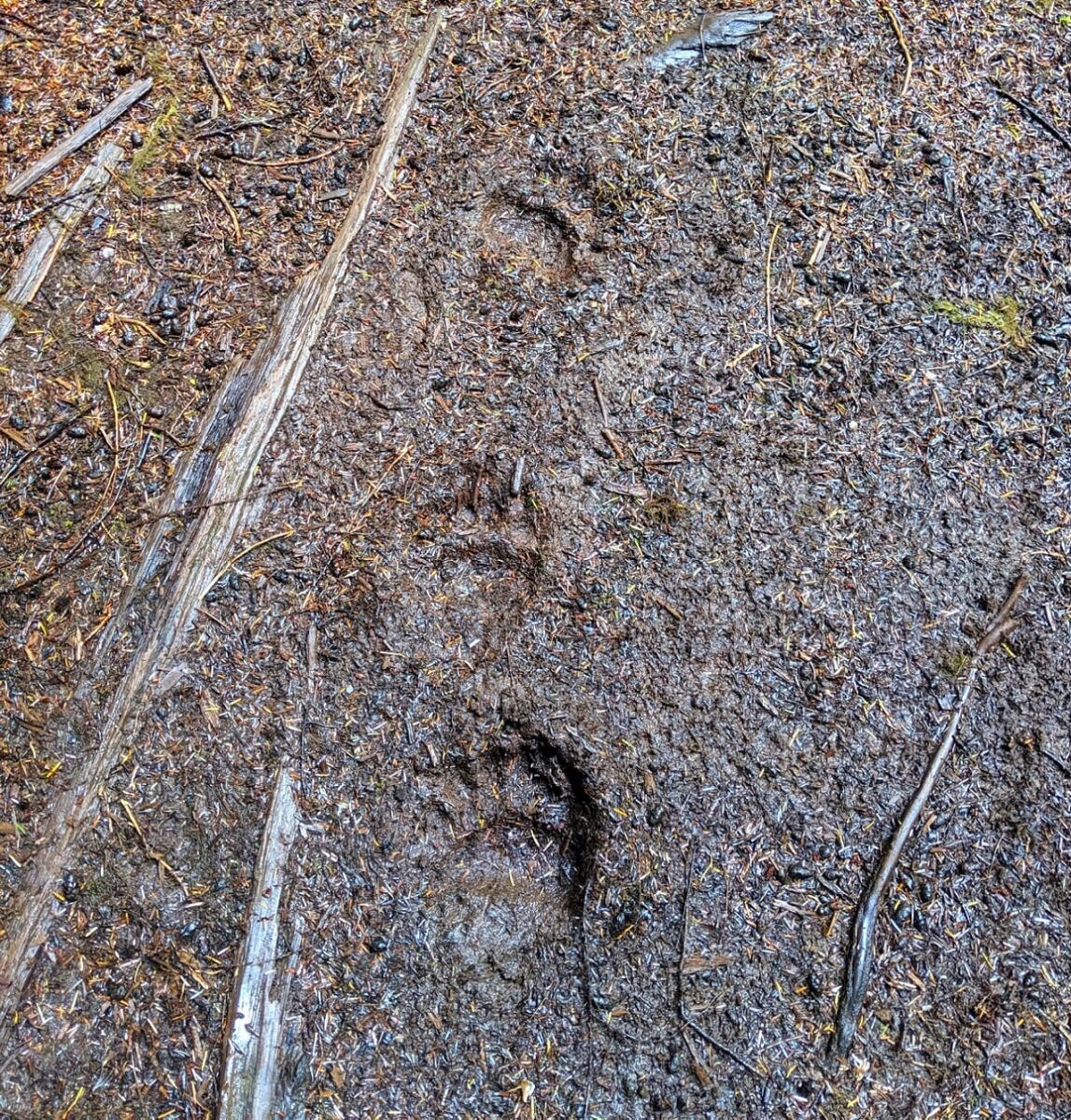
Making noise on the trail
Just as you may not want to meet a bear on a hiking trail, bears don’t like to encounter humans either!
Bears have good hearing and are thought to associate voices with humans. If they hear you, they will usually avoid you.
- The easiest way to alert any potential bear of your presence is to call, sing, clap or talk loudly
- Talking or singing loudly may make you feel a little silly at first, but it is a tried and tested method for avoiding bear encounters
- Increase the volume when it may be more difficult to hear – on windy days or close to streams and dense vegetation
- It’s a good idea to be especially vocal in areas with low visibility. Don’t surprise a bear when coming around a blind corner! Oh, by the way, it’s a myth that bears can’t see well
Like Parks Canada (and other sources), I do not recommend the use of bear bells. They are not considered to be an effective way to communicate a human presence to bears. The repetitive sound can be like background noise (like a bird call or a stream) for bears. It’s also really annoying for other hikers around you!
Bear spray
Bear spray is an aerosol deterrent made with chilli pepper oil. It’s designed to be deployed at close range (less than 10m) towards the face of an aggressive or charging bear.
It causes the eyes, nose and lungs of a bear to swell, restricting their breathing and sight. In most cases, the bear will then retreat. This allows the user to leave the area safely.
Bear spray is a ‘last resort’ tool, used only when other methods have failed. When deploying bear spray, you use the entire 225g canister. It empties in around 7-9 seconds.
Some studies have shown that bear spray is more effective than shooting a bear with a gun.
There has been further debate regarding the truth of this, however, but the fact remains that bear spray is the one of best defences the average person can have against an aggressive bear.
When carrying bear spray, you should have it stored in an easily accessible place and know how to use it. If the occasion arises, you want to be able to deploy it fast.

What to do if you see a bear
This section is informed by information published by BearSmart, WildSafeBC, Parks Canada and BC Parks.
In the event that you see a bear:
- Stop
- Stay calm
- Have your bear spray ready (take the safety off)
- If in a group, stay together
Never:
- Run
- Drop your bag
- Scream
- Make sudden movements
- Turn your back on the bear
- Block the bear’s escape route
Always remember that bears are stronger and faster than you.
Bears can see well (especially at night) and their hearing is twice as good as ours. They generally do not want to attack you, however.
If the bear is in the distance
- Do not approach
- Give the bear plenty of space
- If the bear is moving, wait at a safe distance
- If you can, make a wide detour around the bear
- Move slowly away without getting its attention
- Be prepared to turn around and go back the way you came if necessary
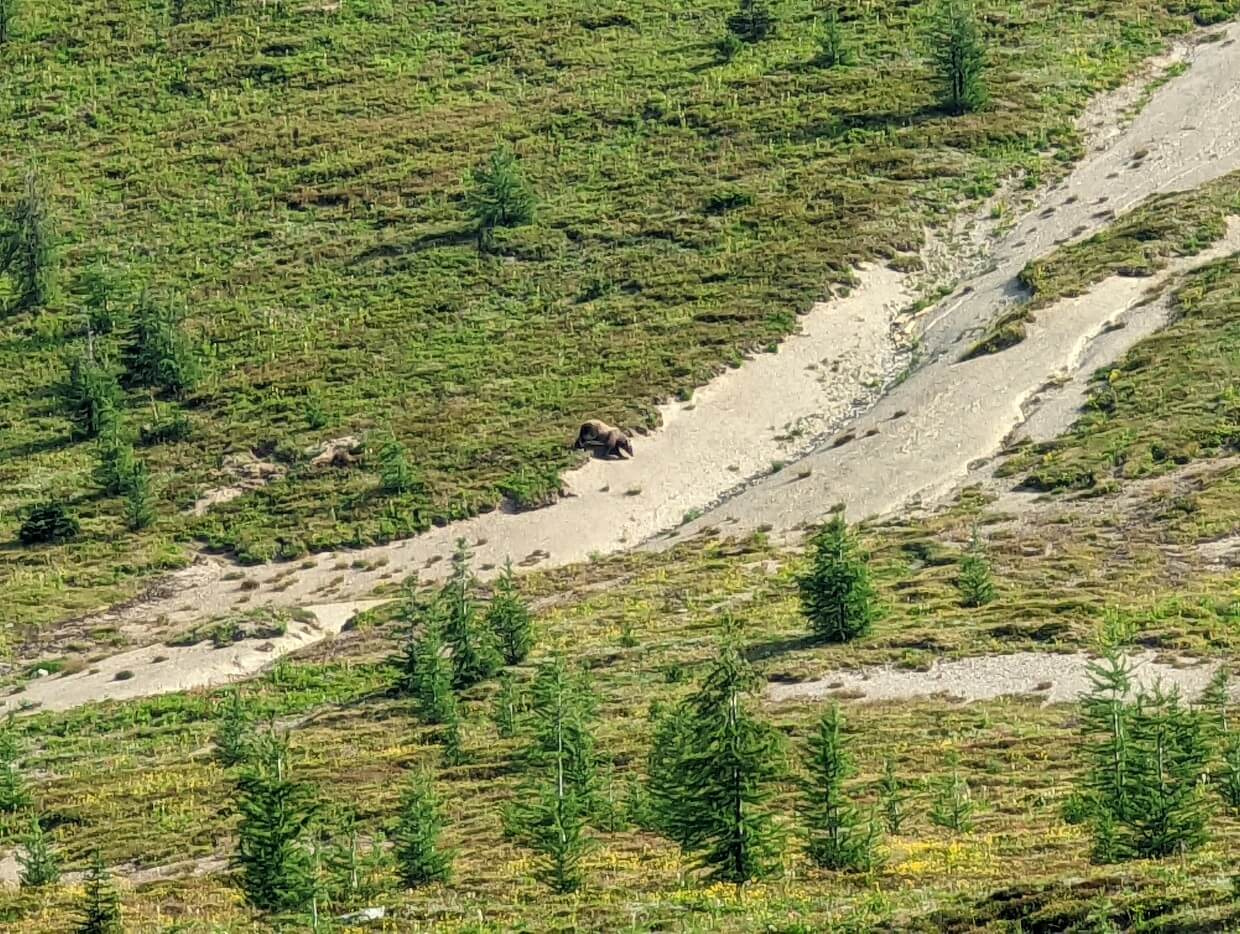
If the bear is close
If the bear is surprised or has cubs/food, it is likely to react defensively. It may appear stressed or agitated (swatting the ground, blowing, snorting). A defensive reaction is most common.
A non-defensive bear could be curious, looking for human food, testing its dominance or in very rare cases, predatory.
The bear’s attention would be clearly directed at you with its head and ears up. Standing up on its hind legs is a sign of curiosity (the bear uses its senses to identify you).
How to respond to a defensive bear
- Remain still and calm
- Talk in a soothing voice
- Start backing away
- Avoid eye contact
- If the bear approaches, stand your ground and prepare to use bear spray
- If the bear makes contact, drop to the ground and play dead. Cover your neck and the back of your head with your hands
- Most defensive attacks last two minutes or less. Remain still afterwards and wait for the bear to leave the area
- If the attack doesn’t stop, fight back
How to respond to a non-defensive bear
- Remain calm
- Talk in a firm voice
- Move out of the bear’s way
- If the bear follows, stand your ground and switch to aggressive behaviour
- Look the bear in the eyes, shout, stamp your feet, make yourself look bigger, hit it with whatever you have, take a step towards the bear
- If the bear still approaches, use your bear spray and fight back
- Concentrate your attack on the bear’s face (nose, and eyes specifically)
There is no perfect strategy for responding to a bear attack.
That is why it is so much better to avoid a negative encounter in the first place. For more information, check out BearSmart
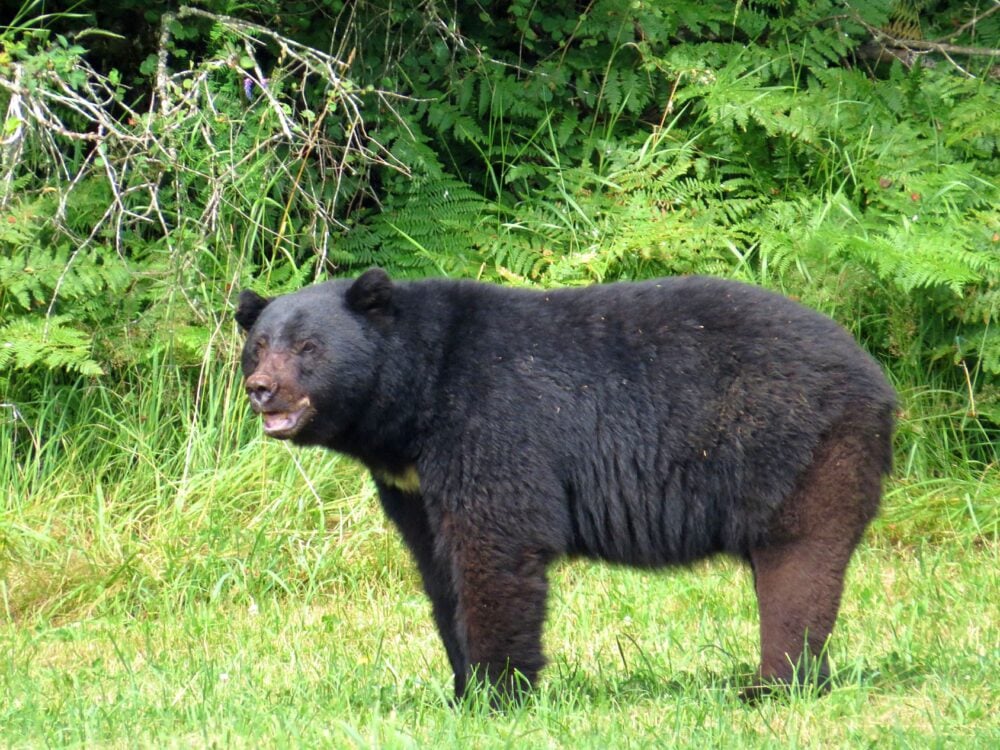
How to camp safely
Anything that has an odour can attract wildlife. Avoid inviting a bear or other wild animal to your campsite with the following tips!
Frontcountry camping
Also known as ‘car camping,’ this style of camping is accessible by vehicle.
A frontcountry campground usually has facilities including (but not limited to) allocated campsites, water, outhouses (or flush toilets), trash bins and even showers.
The easiest way to be ‘bear-safe’ at a frontcountry campground is to think ‘bare’!
Your campsite should look almost empty when you’re not there, with only camping furniture left (tent, chairs etc).
- First, research the campground you are planning to go to. Are there any restrictions or recommendations relating to bear or other wildlife activity?
- Store all food, food-related items and toiletries in a hard-sided vehicle (RV, car, van) when not in use. This includes cooking equipment, garbage, dishes, coolers, drink containers etc.
- Campers without a hard-sided vehicle (such as cyclists) should be prepared to hang their food if storage lockers are not provided. More information in the ‘backcountry camping’ section below
- Do not leave pets unattended. They can attract coyotes and wolves as well as bears! Pet bowls and food should be stored securely too
- Keep your campsite clean. Wash dishes soon after eating, wipe up any food spills, pick up food scraps and dispose of any garbage in the provided bins
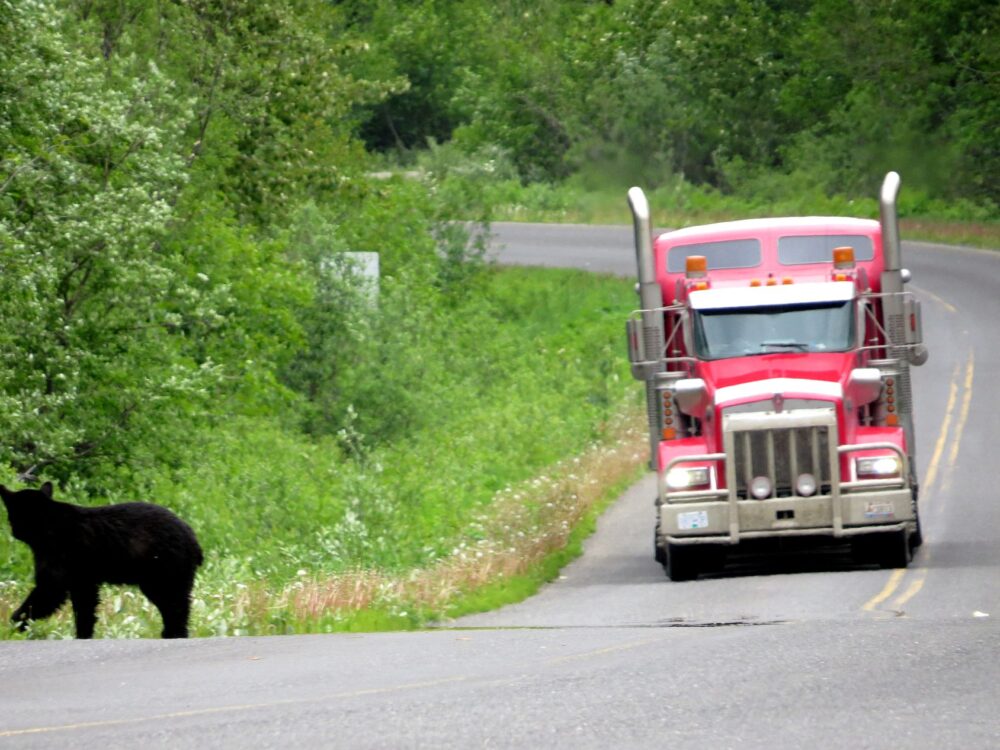
Backcountry camping
A backcountry campsite is one situated in a wilderness area, only accessed by foot, bike, horse, boat or plane. Facilities are limited.
- First, research the backcountry area you are planning to go to. Are there any restrictions or recommendations relating to bear or other wildlife activity? Is food storage provided?
- If you’re not staying in an established backcountry campground, pick your tent spot carefully. Avoid berry patches, game trails or thick brush. Look for animal carcasses
- Don’t cook or eat where you sleep! If there is a designated cooking shelter or cooking area, use it. If not, head at least 50m (preferably 100m) downwind from your tent
- Disperse graywater properly. Strain food particles with a metal screen and add them to your garbage bag. For the greywater itself, use the disposal pit (if provided) or bury/scatter away from water sources
- Clean up thoroughly after cooking, being sure to pick up all garbage, food scraps and crumbs (even if ‘biodegradable’!)
- Never burn garbage or food in a campfire. The smell can linger and attract bears
- Keep your sleeping bag, tent and sleeping clothes away from the food preparation area. Clothes with spilt food on them should be stored with other smelly items (see below)

Storing food in the backcountry
When backcountry camping, one of the most important aspects of bear safety is storing food and smelly items properly. When not in use, food, toiletries, cooking equipment and garbage should be stored securely, away from your tent.
- Some established backcountry sites will have a food cache (a metal bear-proof container) or bear pole system
- Be prepared to create a bear hang, in the situation there is no food storage system provided at the campground (or it is unusable). You’ll need a carabiner, dry/stuff sack and at least 15m (50 feet) of nylon cord
- Alternative solutions include the Ursack (a lightweight, collapsible puncture-resistant bear bag) or a bear barrel/canister. The latter is thick plastic container with a bear-resistant lid
JR and I usually build a bear hang when storage facilities aren’t provided. For trips heading to alpine areas (where trees can be scarce), we bring our Ursack.
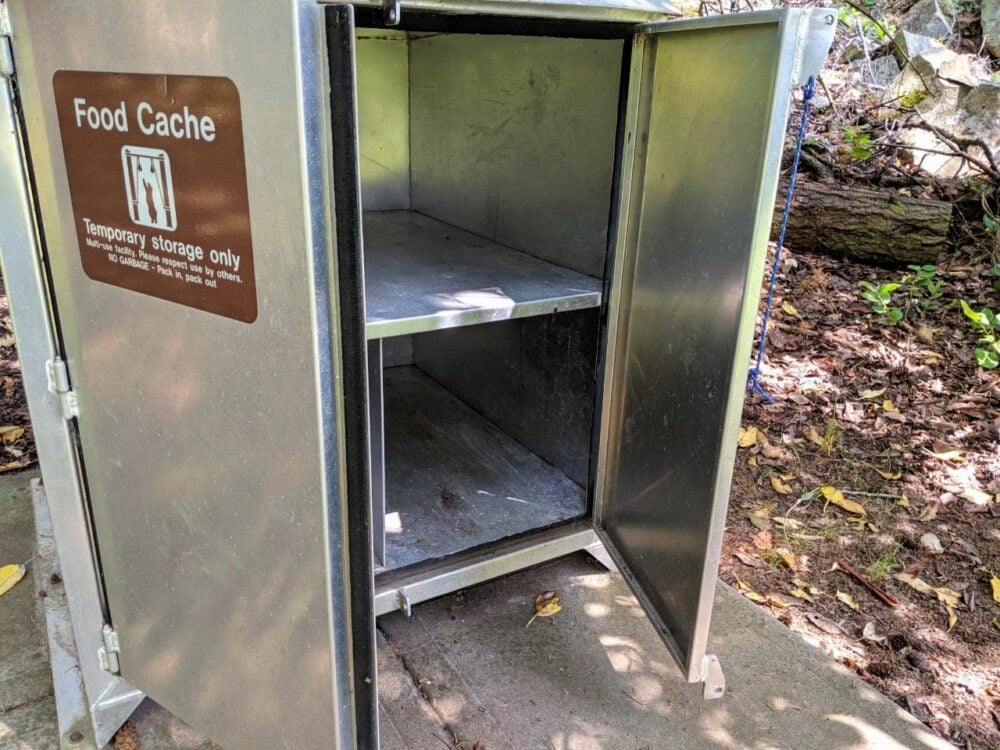
Safe roadside bear viewing
The most common way to see a bear in Canada is from your vehicle.
Seeing a bear by the road is always exciting but the experience can be hazardous for both you and the bear.
Here are some tips:
- Consider not stopping at all. Undisturbed bears can forage more successfully, enabling them to build up needed fat reserves
- Driving by slowly (when safe to do so) is the next best way to minimise your impact
- If you decide to stop, pull off the road safely without blocking other traffic
- Stay a respectful distance away from the bear and make sure it has an escape route
- Do not leave your vehicle!
- Remain aware of other vehicles – move on if the situation becomes crowded
- Keep your observation time short
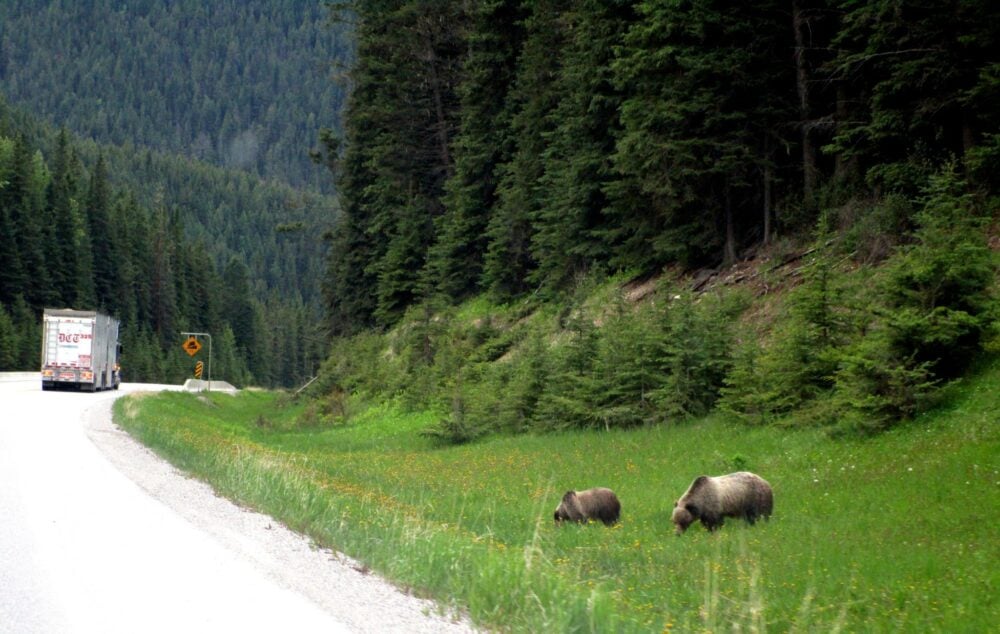
Bear safety essentials
Bear spray, as you may guess, is an absolute given. JR and I carry one canister each. Some may say this is overkill but I like having a back-up.
Bear spray should be stored somewhere with convenient access. We personally use holsters to secure the bear spray to our hip, using a belt. When I’m wearing leggings, I often wear a waist belt and attach the bear spray to that.
To buy bear spray, head for an outdoor gear store. I love to support local businesses when I can, but you can also reliably find bear spray at MEC, Canadian Tire, Cabela’s etc.
When you purchase bear spray in Canada, you’ll need to sign a waiver to assume all risks when using.
The propellant in bear spray loses its potency over time – brand-new bear spray will typically expire after 2 to 2.5 years.
If you’re visiting Canada from an international destination, be aware that you cannot bring bear spray onto a plane. So you can’t bring it with you or take it home. Some outdoor stores (especially around Banff) rent bear spray.
We also sometimes bring a mini air horn. It delivers a shockingly loud sound that would startle any nearby bear. It could also be used to send a distress signal if needed.
Please see the backcountry camping section for more information about additional equipment required for multi-day adventures.

Bear encounters: my experience
One question we get asked a lot about our outdoor adventures is ‘how many bears do you see?’
The truth probably sounds pretty boring – not many.
And that’s OK with me. Don’t get me wrong; bears are beautiful, extraordinary creatures. It’s an incredible experience to be able to see them from an appropriate distance.
Each year, JR and I hike around 500-700km in Western Canada. We typically see one or two bears a year. There have been years, however, when we don’t see any at all.
In October 2019, we had three different (close-contact) bear encounters:
- Arriving into the Cape Scott parking lot after an overnight 34km backpacking trip, we found a black bear standing about 20m from our vehicle
- Walking a friend’s dog in a local park in Courtenay, I noticed two black bears sitting in a tree. There was a river nearby, filled with salmon
- While returning to our vehicle after attempting to harvest oysters in Nanoose Bay, a black bear was walking towards us on the path. We were about 600m from our parking spot
The thing that all these experiences have in common (besides being on Vancouver Island!), is that we were not in a wilderness setting.
Cape Scott is reasonably remote but when we saw the bear, we were in a ‘developed’ area of the park, somewhere that anyone with a vehicle could access.
Bear encounters are uncommon, and dangerous ones even rarer. But bears live and travel closer to humans than you may expect. This is why bear awareness is so important. And also the reason why I carry bear spray on all trails, even short ones!
Preparation, proactive avoidance and knowledge are key when it comes to bear safety. Never be complacent.

Bear safety: further reading
All of the information contained in this post is based on first-hand experiences, discussions with Parks Canada Rangers and the following sources:



Other related articles you may find helpful:
The 10 Essentials for Exploring the Backcountry
How to Leave No Trace When Exploring the Outdoors
How to Stay Safe in the Outdoors
What to Wear in Canada in Winter: A Complete Guide
Snowshoeing 101: A Beginner’s Guide
How to Go Camping in BC Without a Reservation
Check out these recently published articles next

One half of the Canadian/British couple behind Off Track Travel, Gemma is happiest when hiking on the trail or planning the next big travel adventure. JR and Gemma are currently based in the beautiful Okanagan Valley, British Columbia, Canada. Consider buying us a coffee if you have find any of our guides helpful!


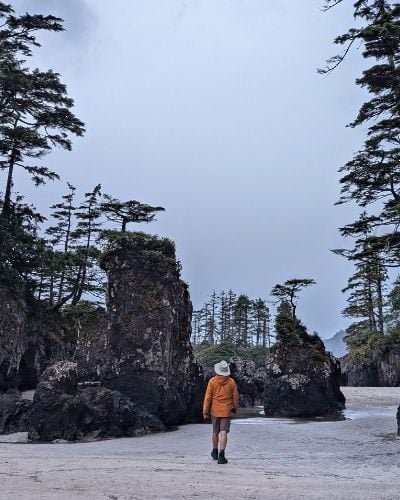

Are you sure about having to sign a waiver when buying bear spray in Canada, as I have never been asked to, and I have never seen anyone else sign one and I work at Canadian Tire.
Interesting! Yes, you have to sign a waiver to help the retailer comply with the Pest Control Products Act of Canada. Bear repellents are registered under the Pest Control Products Act. I learned about this when I managed an outdoor retail store. I’ve always had to complete a waiver when buying bear spray in Canada (various locations including MEC and independent retail stores). I’m curious why this would not be the case at Canadian Tire.
@Gemma, last year I signed a waiver at the Canadian Tire in Canmore, Alberta.
Thanks for letting me know!
Hi Gemma thanks for the article! Me and my partner are coming on a IEC visa from the UK and are hoping to buy a van to travel in. When you ‘wild camped’ in your van in bear country, did you store food out of the van or in whilst you were sleeping?
Interested how this works, as obviously if you were camping you’d keep it hung on a tree etc!
Hi Megan,
Yes, storing food in vehicles is the most appropriate method to use. It’s very rare for bears to break into vehicles in the hope of finding food. In the cases when it does happen, it’s usually because the bear is either predatory and/or has been conditioned to understand that vehicles may have food in them. In either case, those bears are usually put down (which is obviously very sad).
My partner and I have had more issues with mice in our van than bears. And we’ve camped for over 800 nights (at a guess) in a few different vans over the years. Including in places like Yukon, Northern BC etc.
Just reading this page but wanted to mention that black bears aren’t on Prince Edward Island since the 1930’s
—————————————
(“Black bears are the most commonly seen bear in Canada, living in every province and territory”)
Thanks for that! I have visited PEI quite a few times and am surprised I did not know that! I’m shocked to find out that they were wiped out in 1927.